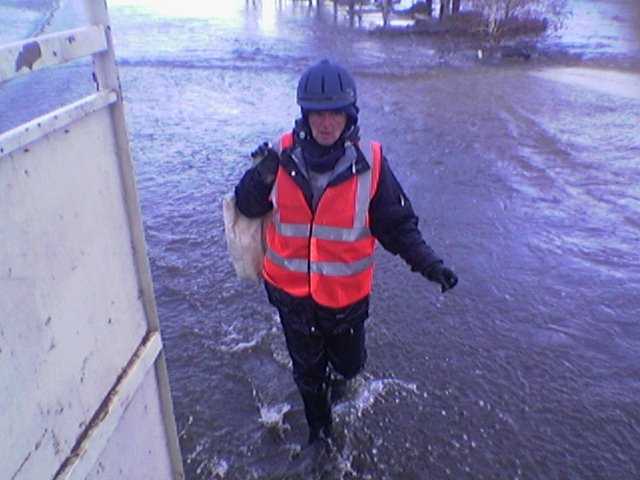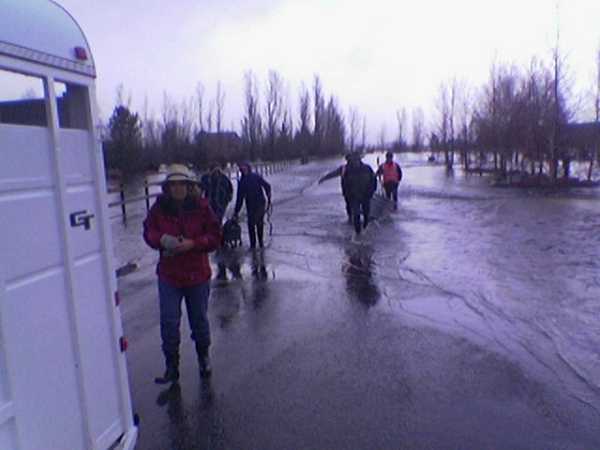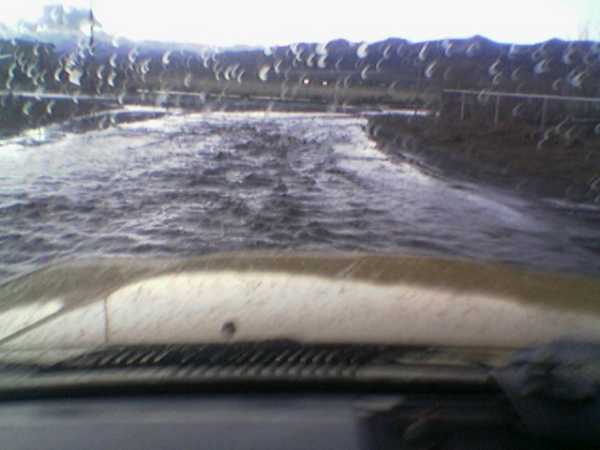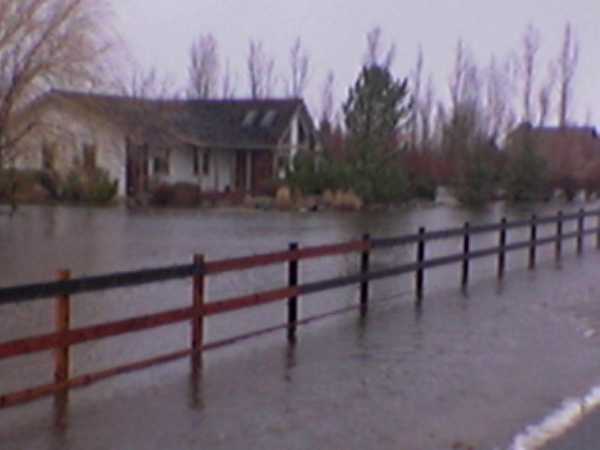LARGE ANIMAL RESCUE SKULL SESSION
|
IT WAS A DARK AND STORMY NIGHT
HOW THE INCIDENT WAS RESOLVED
|
|
This problem is based on a real scenario and is presented for a "Skull Session" discussion in the Technical Large Animal Emergency Rescue Facebook Group.
Location The incident has occurred in an Eastern Sierra valley that catches a great deal of rain and snow runoff. Date and Time January 2nd, AM Incident Details An unseasonal subtropical wave has blown in from the Pacific Ocean with heavy rains that significantly eroded the snow pack. You have been called to a neighborhood that was flooding and contained various forms of livestock. The location is accessible via flooded paved roads. The water current is not swift but it is moving steadily and is very icy. Traveling on foot requires at times walking up to your waist in moving, muddy water. Upon arrival you find stranded animals. A group of goats are perched on an overturned stock tank. Some donkeys are standing in a corral with water up to their chests. A horse is standing in a corral with water up to his belly. Pot bellied pigs are standing in a shed with their heads barely above water. There are some fowl present. To get to the animals you have to walk up a flooded driveway that crosses a ditch. The water in the ditch and over the driveway is moving significantly. You have on hand the usual animal evacuation supplies (lead ropes, halters, long ropes, etc.) and whatever you can find in the water on the flooded property. This incident has occured in a wide-area emergency where other resources that would otherwise be available are being held in other specific areas due to the potential of roads and bridges being closed. As a result, no additional resources are available to you. This is a location where septic tanks are required to be mounded and you can see that there is a relatively stable mound showing above the water line that is accessible behind the house. The scene on your approach.
|
| ACTUAL RESCUE ACTIVITIES |
In this incident a number of county volunteer resources were staged and held in fixed positions for actual and potential localized flooding over wide area. During this period a request was received from a team in another county to assist with removing a variety of animals in the Carson River 50-year flood plain. One crew was released to respond and assist the Douglas County crew.
Upon arrival in the area we checked-in at the nearest Sheriff's checkpoint and determined the safest route into the area and various routes to get out. Then we staged the two trailers at a location closest to the animals where the pavement was even with or barely below the water.
The movement of the water wasn't rapid, but suggested significant tow in the deeper areas.

Our priorities included safety for the rescuers, monitoring conditions so we wouldn't get stranded, identifying the safest way to access the animals, mitigating safety problems and identifying what animals were on the property. One member was assigned to stand by the trailers and monitor conditions.
The most significant safety issues involved submerged hazards and identifying areas of deep and/or fast moving water that needed to be avoided.
Primary resources needed included ropes to rig as hand-hold lines in treacherous locations and to move animals. We used sticks found on site (floating on site, actually) to probe the water as we proceeded to the rear of the property to locate animals. No other human resources were available although they would have been useful. Flotation safety vests would have been desirable but were not available. (We now carry life vests as part of our primary "go kits.)
The next decision involved which animals to remove and which animals could be sheltered in place. Horses were tall enough to walk through the water that was waist-high in some places. Two donkeys were at risk of having to swim out. Goats had to be carried out. More problematic were a couple of potbellied pigs.
The property had a mounded septic tank and the mound was above the water line. The water was not forecast to significantly rise any further. We found a route by probing the water where the donkeys could be led from their flooded corral to the septic tank mound, so they were sheltered in place.
Horses could be led safely to the trailer.
To get the goats out, we found a submerged steel stock tank. Given that the tank was under water, it was not difficult to turn it over and empty it. Once empty it made a great "boat" in which the goats could be floated out.
Leading a horse out and a goat that jumped out of the boat once on the road.
Another goat is still being "boated" using the emptied stock tank.

The pot bellied pigs were a problem. They would not go into the stock tank boat and they were too heavy to carry. We were able to stack pallets and other materials in their shed and get them to climb up onto them to shelter in place. Once they were out of the water, they seemed content enough.
We were able to get all of the animals into the Douglas County crew's trailer for transport to local shelter.
By this time the light was waning and we needed to exit the flood area while we could readily see the flooded road. In addition we were concerned about the Carson River bridge on State Route 88 as the water was lapping at the sides of the bridge when we responded to the incident. We also needed to get the wet rescuers into their vehicles and get the heat turned on. One member hastily retrieved our safety hand-hold lines while being extra careful traversing higher risk areas without the lines, we pulled out and checked out with the deputies at the check point where we had entered.
Go to Skull Session Index
Return to the Strike Team LRTC Page
This material is intended for the use of the Technical Large Animal Emergency Rescue (TLAER) Facebook Group. TLAER is a trademark of Technical Large Animal Emergency Rescue. |

